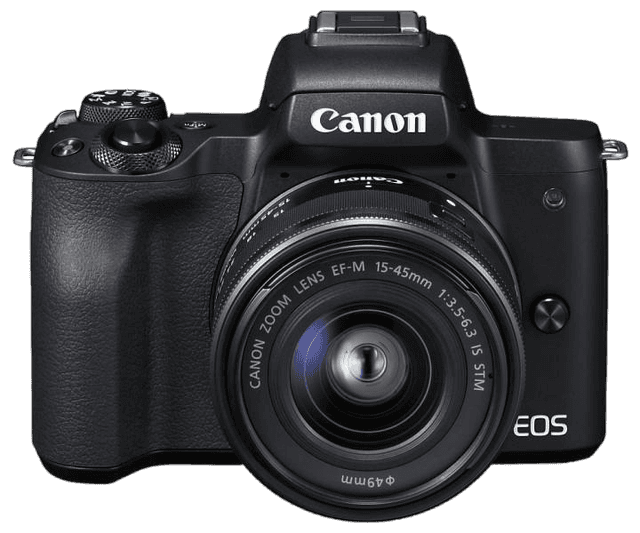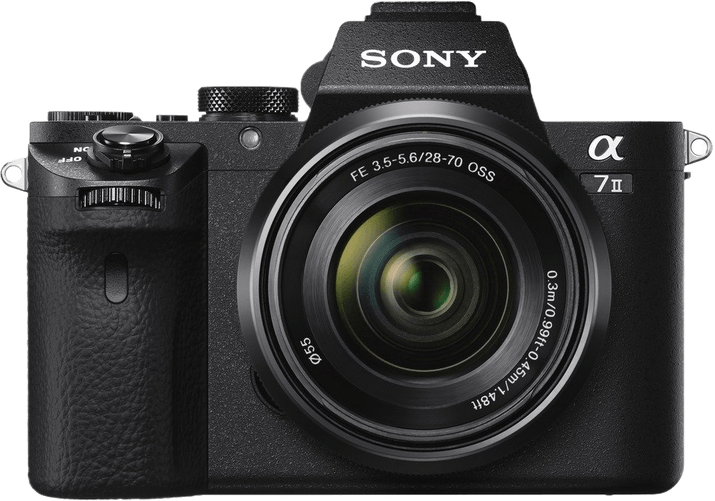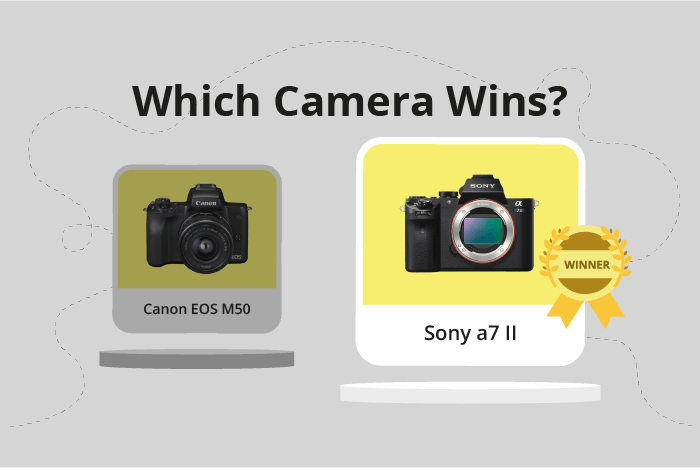Canon EOS M50 vs Sony a7 II Comparison
Canon EOS M50

Sony a7 II

The Sony a7 II emerges as the winner with a score of 69/100, outperforming the Canon EOS M50, which scored 59/100. Both cameras are mirrorless and were launched in 2014 and 2018, respectively. They share similarities in size, with the Sony a7 II measuring 127 x 96 x 60mm and the Canon EOS M50 at 116 x 88 x 59mm.
The Sony a7 II’s higher score signifies its better performance, which is evident in its launch price of $1600 compared to the Canon EOS M50’s $779. However, the Canon EOS M50 has an advantage in weight, being lighter at 390g compared to the Sony a7 II’s 599g.
Taking these specifications into account, the Sony a7 II is a more capable camera, justifying its higher score and price. On the other hand, the Canon EOS M50 offers a more lightweight and affordable option for those prioritizing portability and budget.
Canon EOS M50 vs Sony a7 II Overview and Optics
The Sony a7 II emerges as the winner in optics, with a score of 78/100, while the Canon EOS M50 trails behind with a score of 59/100. Both cameras have 24-megapixel CMOS sensors, but the Sony a7 II has a slight edge with 24.2 megapixels. Additionally, both cameras use different processors – the Canon EOS M50 is equipped with a Digic 8 processor, and the Sony a7 II has a Bionz X processor.
The Sony a7 II excels in several aspects, including a higher DXOMARK score for the sensor (90 versus 58), a full-frame sensor size compared to the Canon EOS M50’s APS-C sensor size, and built-in image stabilization. The full-frame sensor size and superior DXOMARK score contribute to better image quality, while the image stabilization ensures sharper photos, especially in low-light conditions or when using longer focal lengths.
On the other hand, the Canon EOS M50 has a faster shooting speed of 10 frames per second compared to the Sony a7 II’s 5 frames per second. This makes the Canon EOS M50 more suitable for capturing fast-moving subjects or action photography.
Both cameras have different lens mounts, with the Canon EOS M50 using a Canon EF-M mount and the Sony a7 II using a Sony E mount. This factor is essential when considering lens compatibility and future lens investments.
To conclude, the Sony a7 II outperforms the Canon EOS M50 in optics, offering better image quality, sensor size, and image stabilization. However, the Canon EOS M50 has an advantage in shooting speed, making it a viable choice for action photography. Ultimately, the choice between these two cameras depends on the specific needs and priorities of the photographer.
Canon EOS M50 vs Sony a7 II Video Performance
The Canon EOS M50 takes the lead in video capabilities with a score of 91/100, while the Sony a7 II scores significantly lower at 56/100. Both cameras share some common specifications, such as having a built-in microphone, manual focus, and the ability to shoot in various formats.
The Canon EOS M50 outperforms the Sony a7 II in several aspects. Firstly, it offers a higher maximum video resolution of 4K (3840 x 2160) compared to the Sony a7 II’s Full HD (1920 x 1080) resolution. This means the EOS M50 can capture more detailed and sharper videos. Moreover, the EOS M50 has a higher maximum video frame rate of 120fps, whereas the Sony a7 II can only reach 60fps. This enables the EOS M50 to record smoother slow-motion videos. Additionally, the Canon EOS M50 has a built-in time-lapse functionality, which the Sony a7 II lacks, providing more creative options for videographers.
Despite its lower score, the Sony a7 II does have some advantages over the Canon EOS M50. Its full-frame sensor allows for better low-light performance and shallower depth of field. Furthermore, the Sony a7 II has a more advanced image stabilization system, which can help reduce camera shake when shooting handheld video.
Taking these factors into account, it is clear that the Canon EOS M50 is the superior choice for those who prioritize video capabilities. Its higher resolution, faster frame rate, and built-in time-lapse functionality make it a versatile and powerful tool for videography. However, the Sony a7 II still has merit for those who value low-light performance and image stabilization.
Canon EOS M50 vs Sony a7 II Features and Benefits
The Canon EOS M50 outperforms the Sony a7 II in terms of features, scoring 70/100 compared to the Sony a7 II’s 57/100. Both cameras share some specifications, such as a 3-inch screen, flip screen, lack of GPS, and WIFI connectivity.
The Canon EOS M50 excels with its 1,040,000-dot screen resolution, touchscreen capabilities, and Bluetooth connectivity. The touchscreen allows for easier navigation and control, while Bluetooth enhances the camera’s wireless capabilities. These features contribute to the Canon EOS M50’s higher score and make it a more user-friendly option.
The Sony a7 II, despite its lower feature score, has a slightly higher screen resolution of 1,230,000 dots. This provides a marginally clearer display, which may be beneficial for some users. However, the lack of a touchscreen and Bluetooth connectivity are notable drawbacks.
The Canon EOS M50’s higher feature score reflects its superior specifications and user experience. Its touchscreen and Bluetooth connectivity provide added convenience and functionality, making it a better choice for most users. The Sony a7 II’s marginally higher screen resolution is not sufficient to outweigh its shortcomings in other areas.
Both cameras have their strengths and weaknesses, but the Canon EOS M50 is the clear winner in terms of features. While the Sony a7 II has a slightly higher screen resolution, it lacks the touchscreen and Bluetooth capabilities that make the Canon EOS M50 a more user-friendly and versatile option.
Canon EOS M50 vs Sony a7 II Storage and Battery
The Sony a7 II triumphs over the Canon EOS M50 in storage and battery with a score of 35 to the M50’s 13. Both cameras have a single memory card slot and do not support USB charging. However, the Sony a7 II accepts SD, SDHC, SDXC, Memory Stick Duo, Pro Duo, and Pro-HG Duo memory cards, while the Canon EOS M50 only supports SD, SDHC, and SDXC (UHS-I compatible) cards.
A significant advantage of the Sony a7 II is its longer battery life, offering 350 shots compared to the Canon EOS M50’s 235 shots. The a7 II uses the NP-FW50 battery type, whereas the M50 relies on the LP-E12. The Canon EOS M50 does not have any clear advantages in storage and battery over the Sony a7 II.
Considering the differences, the Sony a7 II provides better storage options and longer battery life, making it the superior choice for photographers who require extended shooting sessions and versatile memory card compatibility.
Canon EOS M50 vs Sony a7 II – Our Verdict
Are you still undecided about which camera is right for you? Have a look at these popular comparisons that feature the Canon EOS M50 or the Sony a7 II:

